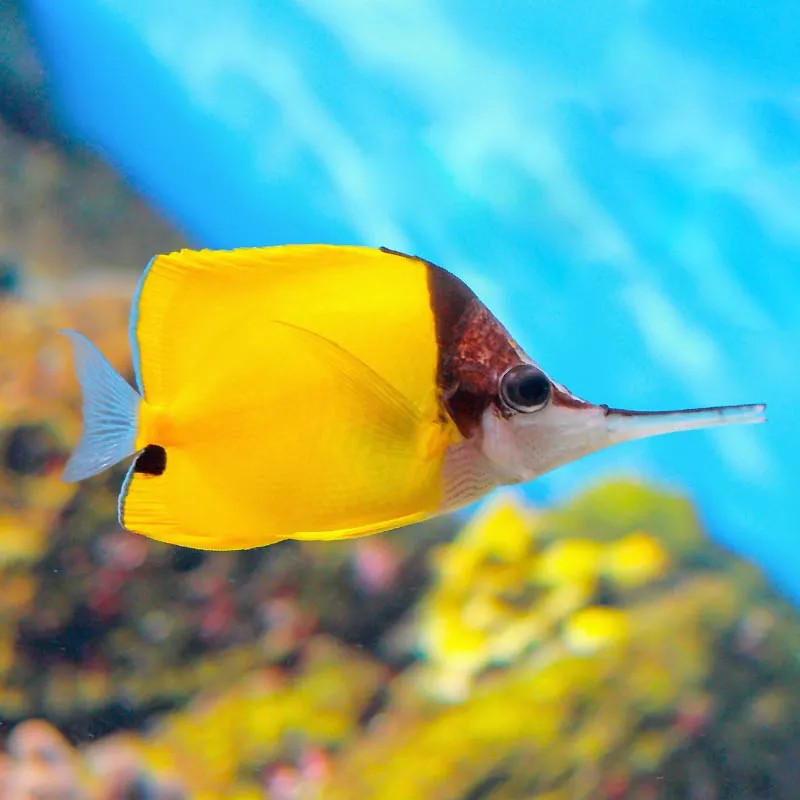Stocks Available
Golden Semilarvatus Butterflyfish - Small
SKU:227128
Chaetodon Semilarvatus
Small

Stock Available
Introduction: • Common Name: Longnose Butterflyfish • Native Habitat: This species is commonly found in the warm, shallow waters of the Indo-Pacific region, particularly around coral reefs, where it thrives among the nooks and crannies of the reef structure. Physical Characteristics: • Appearance: The Longnose Butterflyfish is easily recognized by its elongated snout, which is used to forage for food in tight spaces. Its body features a striking yellow and black coloration, with white and orange accents that enhance its beauty. • Size: Adults typically grow to about 4 to 6 inches (10 to 15 cm) in length. • Fins: They have long, flowing dorsal and anal fins that contribute to their graceful swimming style. Habitat Requirements: • Tank Size: A minimum tank size of 50 gallons is recommended to provide ample swimming space and suitable hiding spots. • Water Conditions: • Temperature: Optimal water temperature ranges from 72°F to 78°F (22°C to 26°C). • pH Level: A slightly alkaline pH between 8.1 and 8.4 is ideal. • Salinity: Maintain salinity levels around 1.020 to 1.025 for healthy living conditions. • Aquascaping: Provide plenty of live rock and coral formations to create hiding places and open swimming areas, mimicking their natural habitat. Diet: • Feeding Habits: The Longnose Butterflyfish is primarily herbivorous, but it also feeds on small invertebrates. • Dietary Options: They thrive on a varied diet that includes high-quality flakes, pellets, and frozen foods like brine shrimp and spirulina. Providing plenty of vegetable matter, such as algae, is essential for their health. • Feeding Frequency: Feed them small amounts multiple times a day to ensure they receive adequate nutrition. Compatibility: • Temperament: Generally peaceful, but they can become territorial, especially around their feeding areas. • Tank Mates: Suitable tank mates include other peaceful reef fish such as clownfish, gobies, and wrasses. • Incompatibilities: Avoid keeping them with aggressive species or those that might nip at their fins, as this can lead to stress. Care Level: • Difficulty: Moderate; while they are hardy, they require stable water conditions and a varied diet to thrive. • Health Monitoring: Regularly check for signs of stress, disease, or parasites, as they can be susceptible to common marine ailments. Breeding: • Breeding Behavior: Breeding in captivity is rare, but in the wild, these fish are known to form pairs during spawning. • Fry Care: If breeding occurs, fry should be raised in a separate tank with appropriate feeding options until they mature. Economic Considerations: • Market Demand: The Longnose Butterflyfish is popular among aquarium enthusiasts for its unique appearance and behavior. • Pricing: Prices can vary based on size and availability, typically falling within the moderate range. Sustainability and Conservation: • Wild Population: Currently, the population is stable, but habitat destruction and overfishing in some areas pose potential threats. • Aquaculture: Some efforts are being made to breed them in captivity, though most specimens in the trade are still wild-caught. Conclusion: The Longnose Butterflyfish is a striking and elegant addition to reef aquariums. With their unique feeding habits and beautiful coloration, they provide interest and activity to any marine setup. Proper care, a well-maintained environment, and compatible tank mates will ensure that these fish thrive, bringing joy to aquarists for years to come.
Data sheet
16 other products in the same category:
Customers who bought this product also bought: